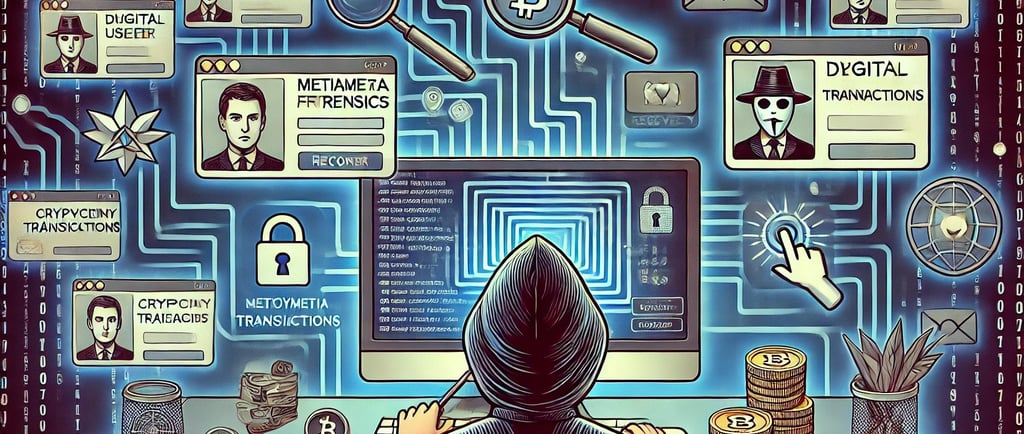The Dark Web's Secret: How Private Investigators Track What You Thought Was Untraceable!
Discover how private investigators use advanced techniques like digital forensics, OSINT, and blockchain analysis to track activities on the dark web. Uncover the truth behind its perceived anonymity and learn how investigators navigate the shadowy digital world to reveal what seems untraceable.
CYBER CRIMEARTIFICIAL INTELLIGENCE OSINTPRIVATE INVESTIGATION DIGITAL SURVEILLANCE PRIVACY FLORIDA


The dark web, often shrouded in mystery and intrigue, has become synonymous with anonymity and untraceability. But is it really as unreachable as it seems? In this comprehensive dive, we'll explore the sophisticated techniques private investigators use to navigate this shadowy digital underbelly, uncovering secrets that could be lurking just beyond the reach of conventional search engines.
Understanding the Dark Web
Before delving into the investigative techniques, it's crucial to understand what the dark web entails. Unlike the surface web, which is indexed by search engines, the dark web operates within the deep web—a part of the internet invisible to conventional search tools. Here, anonymity tools like Tor and I2P provide a level of privacy that, to the uninitiated, seems impenetrable.
The Illusion of Anonymity
The first myth to debunk is the notion of complete anonymity. While the dark web masks IP addresses, making direct tracking difficult, it doesn't erase digital footprints entirely.
Tor Network: Most dark web activities run through the Tor network, which routes internet traffic through multiple nodes. However, each node leaves a trace that, with the right tools and legal permissions, can be deciphered.
Cryptocurrency Transactions: Dark web transactions often use cryptocurrencies for their perceived anonymity. Yet, blockchain analysis can trace these transactions back to exchanges or mixers, where they might be identifiable.
Techniques Employed by Private Investigators
1. Digital Forensics
Private investigators often start with the digital devices of their clients or suspects.
Data Recovery: Deleted files, browser history, and hidden partitions can reveal entry points into the dark web.
Metadata Analysis: Every digital interaction leaves metadata, which can help reconstruct online behaviors, even on the dark web.
2. Open Source Intelligence (OSINT)
Surprisingly, much of what's on the dark web can be traced back to the surface web through OSINT.
Social Media and Forums: Cross-referencing information found on dark web forums with public social media profiles can reveal identities.
Leaks and Data Breaches: Information from leaks often ends up on the dark web. Investigators use tools like Skopenow or SpiderFoot to find connections between dark web data and surface web information.
3. Advanced Search Techniques
Using Dark Web Search Engines: Platforms like Ahmia or Torch allow searches within the dark web, albeit with limitations.
Deep Packet Inspection: With legal authorization, investigators can analyze internet traffic for patterns that might indicate dark web activity.
4. Collaboration with Law Enforcement
While private investigators work independently, they often liaise with law enforcement for access to more advanced tools or when legal boundaries are approached.
Cybercrime Units: Specialized units share insights or tools for tracking dark web activities.
Legal Data Requests: With subpoenas or court orders, ISPs or data centers can be compelled to reveal user information.
Real-Life Examples
Case Study: The Silk Road Investigation
The takedown of Silk Road, a notorious dark web marketplace, showcased how law enforcement, using techniques similar to those of private investigators, infiltrated and dismantled dark web operations.
Undercover Operations: Agents posed as buyers or sellers, gathering evidence over time.
Digital Breadcrumbs: Ross Ulbricht, Silk Road's founder, was traced through mistakes in maintaining his anonymity, such as using the same pseudonyms across different platforms.
Corporate Espionage Case
A multinational company hired a private investigator after suspecting data leaks via the dark web.
Digital Footprint Analysis: The investigator traced IP logs from company devices to specific dark web forums where data was being sold.
Social Engineering: By engaging with sellers on these forums, the investigator confirmed the source of the leaks, leading to internal security measures and legal action.
Ethical and Legal Considerations
Investigating the dark web comes with ethical and legal boundaries:
Privacy Laws: Investigators must navigate privacy laws carefully, ensuring they don't overstep legal boundaries.
Ethical Hacking: While not illegal with permission, accessing systems in ways not intended by their owners requires careful consideration and legal oversight.
Conclusion
The dark web, while a haven for those seeking anonymity, is not impervious to the skills of determined investigators. Through a combination of digital forensics, OSINT, advanced search techniques, and sometimes collaboration with legal authorities, private investigators can track what many believe to be untraceable.
This article aimed to demystify the process, providing insight into the tools and methodologies that make such investigations possible. While the dark web offers shadows, it's not completely dark to those equipped with the right knowledge and tools.


